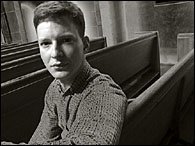Kaleidoscope
Stéphane Perreault: Life in order
 PHOTO: Claudio Calligaris
PHOTO: Claudio Calligaris |
|
Stéphane Perreault has had a more convoluted road than most through his PhD in history. First, he switched to McGill from Laval in 1997 to better research his thesis topic on the education of the deaf in Montreal in the late 19th century. Then he took a year off last year: not to relax or travel but rather to begin the process of becoming a Brother in the order of the clerics of St. Viator.
He is not, stresses Perreault, a monk. The order of St. Viator, known as the Viatorians, has been active in Quebec since the 1840s, mostly as a teaching order. Before the Quiet Revolution the order ran many colleges and schools in the province.
"We're an active congregation, we live in the world. Monks live in one place their whole lives, but we can be called on to move to different places. It's the same religious concentration, but it's a different lifestyle," explains Perreault.
The Viatorians include priests and non-ordained brothers like Perreault. Right now Perreault is in the first year of his temporary vows -- which are the same for all members -- of chastity, poverty and obedience. To take his vows he had to undergo a one-year novitiate (which included a month in Haiti) during which he learned spiritual exercises and studied theology and the Bible.
"It's like marriage -- being a postulate is like courting, the novitiate is like engagement, and taking the vows is like the marriage," he says.
Once Perreault's temporary vows are over he can renew them for another three years, or, if both he and his order are satisfied that he would be a worthy member, he can take his permanent vows. Once that happens, Perreault hopes to begin his studies to become a priest.
But why? Growing up in Joliette, Perreault's family was not overly religious. He was 17 and in CEGEP when he really sat down and thought about what he wanted to do with his life.
"I had a voice inside me that said, 'Why don't you become a religious?' To say I was thunderstruck would be an understatement. I didn't know what to do with this," he said.
Friends suggested he consult a religious order that operated in Joliette -- the Viatorians. And though, over the next few years, Perreault considered joining different orders, it was to the Viatorians that he eventually returned.
He says, "I felt called home to the congregation."
The Viatorians are largely out of the school system in Quebec now, but their three hundred members still follow their original mission of education.
"We've reinterpreted it to teaching within the faith; we help people discover what faith can mean in their own lives. We're really doing missionary work here in Quebec, and helping people reconnect with the spiritual within the framework of Catholicism," says Perreault.
When Perreault leaves the home on Querbes and St. Viateur that he shares with 40 other members of his order to go to Abitibi, he will be leading retreats for youth and teaching them about the catechism.
And although many would see Perreault's vows as binding him, he describes them as liberating in a world increasingly preoccupied with material gratification.
"These evangelical values of poverty, chastity and obedience are not so much rules of conduct, but they are ways to delineate spaces of freedom, of love and of caring around us."
For more information on the Viatorians see www.csviateur.qc.ca or www.viatorians.com
 |
||||
|
There's going to be a September 11 type change in management education. It will hit overnight and will seem dramatic. But really it will have been building for 30 to 40 years. |
||||
Osler reborn
Even for the occasion of the grand reopening of the Osler Library of the History of Medicine, some rules could not be broken.
"If you would like to take a tour, we ask that you leave your food and drinks upstairs, please," said Abraham Fuks, dean of Medicine, to the invited guests who had gathered in the McIntyre's Palmer Howard lecture hall to celebrate the library's renaissance.
The subject of all the fuss was the extensive renovation that the library has undergone over the last seven months.
With the help of a $500,000 grant from Jack McGovern, a prominent Texas allergist and founder of the American Osler Society, and the advice of the Canadian Conservation Institute, the library has installed a new climate control system and undergone major renovations directed by architect Julia Gersovitz.
Pre-1840 books are now accessible in the Osler Room, reached through the Wellcome Camera. Rare books from 1840 to 1918 are stored in a special access area that surrounds the Osler Room. Those in the latter category are more fragile due to acids that were introduced into the papermaking process.
It was only necessary to adapt the McIntyre Building air circulation system for the post-1840 material.
"Now, instead of getting 16 different climates a day, we are only dealing with seasonal variation," said Osler Librarian Pamela Miller.
A high-tech climate control unit -- it looks like a giant fridge and sounds like a futuristic spacecraft -- controls the humidity in the inner area.
Older shelves, many of which were literally bowed from years of bearing their bibliographic burden, were repaired and reinforced. Special compact shelving that allows for 50 percent more storage space is now in place.
Why all the trouble? Though seldom seen by many of the McGill community, the Osler has a special place on campus.
Faith Wallis, professor of the history of medicine and a former Osler Librarian, explained that Osler's chief legacy is not his library, but quite the opposite. In Osler's time, medical education was largely book and classroom oriented.
"He cast aside the textbook and taught students at the bedside," said Wallis.
Despite his emphasis on hands-on education, Osler himself remained a bibliophile. His book collection is a testimony to the humanism with which he approached his profession.
"The library is a thick core of medicine, wrapped in a context of science and philosophy and lit by a halo of religion, cultural history and literature," said Wallis.
 |
||||
|
To be honest, I took a pay cut to come here. |
||||
Prof gets tanked
 Professor Brian Alters submerged
Professor Brian Alters submerged |
|
From being a cop in California to dressing up as a gorilla to promote a lecture on evolution, education professor Brian Alters is used to doing some strange stuff. But his students were left agog by the lengths to which he goes to demonstrate science. Or is that depths?
His teaching science lecture started with a question posed by his assistant, Alex Sheftel: If an object, say a person, were weighed down with 7 lbs in water, what would it take to reach buoyancy? A small ziploc bag filled with air? A freezer-sized one? Neither? After half a minute, Sheftel made the hypothetical real by unveiling a tank of water at the back of the class with Alters (in jeans and blazer) sitting cross-legged inside, holding a sign, "Happy Tuesday" (his usual class greeting).
The class gasped, cried out, laughed, then watched him reach into his pocket and ... pull out a ziploc baggie. With his scuba gear, Alters filled the bag with air. Did he float? No. How 'bout the slightly bigger bag? Just a bit more air raised the waterlogged prof to the surface. He taught the rest of the lecture standing in the tank.
 |
|
The feat's logistics were daunting. It took an hour and a half to fill the 400 lb tank using a hose to the men's room. The combined weight was roughly a ton.
"I wanted to do something to grab their attention," Alters says. "Back in the 1800s people would crowd a class to see a professor's demonstration." It worked. Students appreciated the extra effort. One said, "I'll remember this even after I forget your name."

